Green Transportation-Enabled High-Quality Economic Development in the Yangtze River Economic Belt: Regional Disparities and Dynamic Characteristics
Abstract
1. Introduction
2. Methodology
- (1)
- The entropy weight method is applied based on Information Entropy Theory [34], quantifying data dispersion to avoid subjective bias in weight assignment;
- (2)
- The CRITIC weight method follows Statistical Contrast Intensity and Conflict Analysis [35], optimizing weights through inter-indicator correlations;
- (3)
- Their integration balances data variability and indicator independence, aligning with the systemic principle of regional development evaluation.
2.1. Entropy-Weighted CRITIC Method
- (1)
- Information Content: An indicator that exhibits significant variation across different evaluated objects carries more discriminative information. If all objects have nearly identical values for a particular indicator, that indicator provides little useful information for distinguishing between them.
- (2)
- Entropy as a Measure of Uncertainty: The entropy value () calculated for an indicator (Equation (2)) inversely reflects the amount of information it provides. A lower entropy value indicates less uniformity (i.e., higher variation) in the data for that indicator across the evaluated objects. This implies higher uncertainty reduction or more useful information contributed by that indicator.
- (3)
- Weight Assignment: Consequently, indicators with lower entropy (higher variation, more information) should be assigned higher weights in the composite index, as they play a more significant role in differentiating the performance of the evaluated objects. Conversely, indicators with higher entropy (lower variation, less information) receive lower weights. This process is inherently objective, as the weights are derived solely from the intrinsic variability within the dataset itself, minimizing subjective bias.
2.2. Dagum–Gini Coefficient Method
2.3. Kernel Density Method
3. The Calculation and Difference Analysis of the Economic High-Quality Development Index in the YEB
3.1. Indicators and Data
3.1.1. Selection of Indicators
3.1.2. Analysis of Index Data
3.2. Analysis of the Difference in Economic High-Quality Development Index in the YEB
3.2.1. Analysis of the Difference in Economic High-Quality Development Index at the Provincial Level
3.2.2. Analysis of Differences in HQEDI at the Regional Level
4. Analysis of Regional Differences and Dynamic Characteristics of the YEB
4.1. Analysis of Dagum–Gini Coefficient
4.2. Kernel Density Estimation Analysis
5. Conclusions
- (1)
- Contribution of scientific and technological innovation to economic growth: In the dimension of innovation, Shanghai and Hubei exhibit high levels of scientific and technological investment and innovation contribution. Conversely, Chongqing, Hunan, Anhui, Zhejiang, and Jiangsu have high technological investment but relatively low innovation contribution. Yunnan, Guizhou, Sichuan, and Jiangxi show low input and low contribution, with Yunnan’s situation possibly related to its economic positioning and development stage.
- (2)
- Trade openness and market freedom: Shanghai excels in trade openness and market freedom, whereas Guizhou and Yunnan lag behind in these indicators. Most provinces and cities boast high market freedom but insufficient trade openness, with Zhejiang and Jiangsu being notable exceptions in terms of trade openness.
- (3)
- The YEB (YREB) demonstrates a development pattern of “strong in the east and weak in the west.” The lower reaches, such as Shanghai and Jiangsu, have higher economic development levels. Upstream regions like Sichuan and Chongqing are relatively underdeveloped, while midstream regions such as Hubei and Hunan are intermediate. Overall, HQEDI shows an increasing trend. The average value in downstream regions is higher but grows more slowly, while upstream regions have a faster growth rate.
- (4)
- High-quality economic development difference (Dagum–Gini coefficient): Between 2010 and 2021, the overall YEB HQEDI Dagum–Gini coefficient rose from 0.068 to 0.094, showing a U-shaped trend of rising after falling. This indicates that while regional differences in high-quality development exist, overall inequality is low and trending towards narrowing. There is a significant difference between upstream and downstream regions, but this disparity is gradually decreasing over time. The intra-regional Gini coefficient fluctuates less, while the inter-regional Gini coefficient fluctuates more, indicating that economic differences among provinces (cities) within the same region are minor, with disparities among different river basins being the main contributors to overall economic inequality.
- (5)
- Dynamic characteristics of the kernel density of high-quality economic development: The kernel density curve of the HQEDI in the YEB shifts rightward over time, reflecting improvements in high-quality economic development. However, differences among river basins are evident. The absolute difference in the HQEDI in the upstream region has gradually expanded, showing significant dynamic changes initially and then a steady increase in regional variation. The middle region, after rapid development, currently faces the challenge of increasing absolute differences. The downstream regions continue to improve in high-quality economic development but exhibit strong volatility, with bimodal or trimodal distributions, especially in recent years, indicating a trend of increasing disparity.
6. Limitations and Future Research Directions
6.1. Limitations
6.2. Future Research Directions
- (1)
- Develop Dynamic Weight Models: Use time-varying coefficients (e.g., Markov switching models) to reflect evolving policy impacts on indicator importance.
- (2)
- Model Nonlinear Interactions: Apply coupling coordination models (e.g., CCD) to quantify synergies/trade-offs between green transport, growth, and equity.
- (3)
- Incorporate Smart Transport Metrics: Add indicators like highway IoT coverage or multimodal transport integration efficiency to capture digital enablement.
- (4)
- Assess Ecological Carrying Capacity: Include absolute environmental costs (e.g., total CO2) alongside intensity indicators to align with IPCC carbon budgets.
- (5)
- Conduct Cross-Regional Comparisons: Compare the YREB with basins like the Rhine or Mississippi to identify transferable governance strategies.
- (6)
- Analyze Micro–Macro Linkages: Integrate enterprise-level surveys (e.g., logistics decarbonization) with provincial data to reveal transmission mechanisms.
7. Policy Recommendations
7.1. Enhance Innovation and Technological Investment
7.2. Promote Trade Openness and Market Liberalization
7.3. A Dynamic Policy Dashboard
7.4. Reduce Economic Inequality
7.5. Strengthen Environmental and Ecological Policies
Supplementary Materials
Author Contributions
Funding
Institutional Review Board Statement
Informed Consent Statement
Data Availability Statement
Conflicts of Interest
References
- Deng, M.; Zhang, B.; Wu, C. The Institutional Arrangements and Local Responses for Promoting Green Development of the Yangtze River Economic Belt. Econ. Res. Yangtze River Basin 2024, 1, 99–130. [Google Scholar]
- Kowalski, A.; Nowak, J.; Wiśniewski, T. Transport of goods on the example of a selected section of transport in Poland. Sci. J. Silesian Univ. Technol. Ser. Transp. 2023, 121, 89–102. [Google Scholar]
- Pan, S. Research on the Spatiotemporal Differences and Evolution of Chinese-Style Modernization in the Yangtze River Economic Belt. Resour. Environ. Yangtze Basin 2024, 33, 1369–1381. [Google Scholar]
- Qin, Z.; Huang, B.; Huang, Y. Research on the Construction of Provincial Sub-Center Cities in the Yangtze River Economic Belt. Econ. Res. Yangtze River Basin 2024, 1, 211–241. [Google Scholar]
- Li, Z.; Wu, F.; Zhang, F. A multi-scalar view of urban financialization: Urban development and local government bonds in China. Reg. Stud. 2022, 56, 1282–1294. [Google Scholar] [CrossRef]
- Ball, A.A.; Gouzerh, A.; Brancalion, P.H. Multi-scalar governance for restoring the Brazilian Atlantic Forest: A case study on small landholdings in protected areas of sustainable development. Forests 2014, 5, 599–619. [Google Scholar] [CrossRef]
- Xing, Z.; He, C. Regional Imbalance: Theoretical Review, Research Progress and Future Outlook. Prog. Geogr. 2024, 43, 1839–1852. [Google Scholar]
- Li, S.; Chen, W. Regional carbon inequality and its impact in China: A new perspective from urban agglomerations. J. Clean. Prod. 2024, 480, 144059. [Google Scholar] [CrossRef]
- Yang, J.; Huang, G. Study on the mechanism of multi-scalar transboundary water security governance in the Shenzhen River. Sustainability 2024, 16, 7138. [Google Scholar] [CrossRef]
- Tang, L.; Hu, X.; Luo, Z.; Wei, B.; Wang, Y.; Zhang, Y.; Shao, R.; Chen, C. The Spatiotemporal Coupling of Ecological Fragility and Urbanization Level and Their Interactive Influencing Factors: A Case Study of Hunan Province. Acta Ecol. Sin. 2024, 44, 4662–4677. [Google Scholar]
- Chao, W.; Zhou, W. Analysis of the Evolution and Driving Forces of the Territorial Spatial Pattern of the Middle Reaches Urban Agglomeration in the Yangtze River from the Perspective of Three Zones. Resour. Environ. Yangtze Basin 2024, 33, 1489–1503. [Google Scholar]
- Zhang, X.; Gao, W. Evaluation and Difference Analysis of High-Quality Economic Development. Inq. Econ. Issues 2020, 4, 1–12. [Google Scholar]
- Bo, S.; Zhang, B. Measurement and Analysis of High-Quality Economic Development in Cities Above the Prefecture Level Nationwide. Soc. Sci. Res. 2019, 19–27. [Google Scholar]
- Yu, W.; Rong, J.; Nian, C. Construction and Measurement of High-Quality Economic Development Evaluation System in Inner Mongolia. J. Inn. Mong. Univ. (Nat. Sci. Ed.) 2020, 51, 441–448. [Google Scholar]
- Sun, H.; Gui, Q.; Yang, D. Measurement and Evaluation of High-Quality Economic Development in Chinese Provinces. Zhejiang Soc. Sci. 2020, 8, 4–14. [Google Scholar]
- Tian, H.; Guo, M.; Qin, J. Research on the Impact of Digital Economy on High-Quality Development of the Yangtze River Economic Belt: Evidence from 108 Prefecture-Level Cities. J. Ind. Technol. Econ. 2023, 42, 17–25. [Google Scholar]
- Guo, Y.; Jiang, X.; Zhu, Y.; Zhang, H. Measurement and spatial correlation analysis of high-quality development Level: A case study of the Yangtze River Delta urban agglomeration in China. Heliyon 2024, 10, e29209. [Google Scholar] [CrossRef]
- Zhao, J. How do innovation factor allocation and institutional environment affect high-quality economic development? Evidence from China. J. Innov. Knowl. 2024, 9, 100475. [Google Scholar] [CrossRef]
- Zhang, X.; Zhang, Y.; Zhang, Z. The Measurement, Spatiotemporal Evolution, and Dynamic Spatial Convergence of China’s High-Quality Economic Development Level. Inq. Econ. Issues 2024, 1, 15–37. [Google Scholar]
- Liu, X.; Zhang, X. Research on the evaluation of high-quality development level of green economy in provinces and cities in the Yangtze River Economic Belt based on the five development concepts. For. Econ. 2024, 46, 28–50. [Google Scholar]
- Zhou, Z.; Dai, H.; Zha, Y. Research on the Dilemma and Countermeasures of Digital Transportation Empowering High-Quality Economic Development. China Soft Sci. 2023, 9, 86–94. [Google Scholar]
- Zeng, S.; Fu, Q.; Haleem, F.; Han, Y.; Zhou, L. Logistics density, E-commerce and high-quality economic development: An empirical analysis based on provincial panel data in China. J. Clean. Prod. 2023, 426, 138871. [Google Scholar] [CrossRef]
- Zhao, W.; Xu, X. Digital Economy, Spatial Effect, and High-Quality Economic Development: A Case Study of 110 Cities in the Yangtze River Economic Belt. East. China Econ. Manag. 2023, 37, 42–49. [Google Scholar]
- Zhang, F.; Tan, H.; Zhao, P.; Gao, L.; Ma, D.; Xiao, Y. What was the spatiotemporal evolution characteristics of high-quality development in China? A case study of the Yangtze River economic belt based on the ICGOS-SBM model. Ecol. Indic. 2022, 145, 109593. [Google Scholar] [CrossRef]
- Guo, Y.; Xie, W.; Yang, Y. Dual green innovation capability, environmental regulation intensity, and high-quality economic development in China: Can green and growth go together? Financ. Res. Lett. 2024, 63, 105275. [Google Scholar] [CrossRef]
- Xie, D.; Rong, Y.; Ye, Z. High-Quality Urban Development and Coordinated Urban Agglomeration Development: From the Perspective of Marx’s Differential Rent. Econ. Res. J. 2022, 57, 156–172. [Google Scholar]
- Liu, W.; He, F. Research on the Construction of an Indicator System for High-Quality Development of China’s Economy and Its International Comparative Study. Explor. Econ. Issues 2023, 9, 15–33. [Google Scholar]
- Feng, D.; Li, C.; Deng, S. Study on the Decoupling Effect and Driving Factors of Tourism Transportation Carbon Emissions in the Yangtze River Delta Region. Sustainability 2025, 17, 3056. [Google Scholar] [CrossRef]
- Sen, A. Development as freedom (1999). In The Globalization and Development Reader: Perspectives on Development and Global Change; Wiley-Blackwell: Hoboken, NJ, USA, 2014; pp. 525–562. [Google Scholar]
- OECD. OECD Inclusive Growth Framework; OECD Publishing: Paris, France, 2020. [Google Scholar]
- Romer, P.M. Endogenous Technological Change. J. Political Econ. 1990, 98 Pt 2, S71–S102. [Google Scholar] [CrossRef]
- Stern, D.I. The Rise and Fall of the Environmental Kuznets Curve. World Dev. 2004, 32, 1419–1439. [Google Scholar] [CrossRef]
- North, D.C. Institutions. J. Econ. Perspect. 1991, 5, 97–112. [Google Scholar] [CrossRef]
- Saez, E.; Zucman, G. The Triumph of Injustice: How the Rich Dodge Taxes and How to Make Them Pay; WW Norton & Company: New York, NY, USA, 2019; Chapter 7. [Google Scholar]
- Shannon, C.E. A Mathematical Theory of Communication. Bell Syst. Tech. J. 1948, 27, 379–423. [Google Scholar] [CrossRef]
- Diakoulaki, D.; Mavrotas, G.; Papayannakis, L. Determining Objective Weights in Multiple Criteria Problems: The CRITIC Method. Comput. Oper. Res. 1995, 22, 763–770. [Google Scholar] [CrossRef]
- Ezcurra, R.; Pascual, P.; Rapún, M. The dynamics of regional disparities in Central and Eastern Europe during transition. Eur. Plan. Stud. 2007, 15, 1397–1421. [Google Scholar] [CrossRef]
- Xiang, S.; Qiang, Y. Problems and Paths of Digital Empowerment for the Construction of Urban-Rural Dual Circulation System: A Case Study of Xuancheng City, Anhui Province. J. Yunnan Agric. Univ. (Soc. Sci.) 2022, 16, 72–80. [Google Scholar]
- World Bank. Transport TFP Measurement Guide; World Bank Group: Washington, DC, USA, 2021; p. 38. [Google Scholar]
- European Commission. European Innovation Scoreboard 2023; Publications Office of the European Union: Luxembourg, 2023. [Google Scholar]
- Lucas, R.E. On the mechanics of economic development. J. Monet. Econ. 1988, 22, 3–42. [Google Scholar] [CrossRef]
- Henderson, V. The urbanization process and economic growth: The so-what question. J. Urban. Econ. 2003, 53, 89–112. [Google Scholar]
- Luo, T.; Zhang, Y. A Study on the Coupling Coordination between High-Tech Industry Technological Innovation and Regional High-Quality Economic Development. J. Univ. Shanghai Sci. Technol. 2024, 5, 567–579. [Google Scholar]
- Liu, J. A Study on the Impact of the Digital Economy on High-Quality Economic Development from the Perspective of Efficiency. Ph.D. Thesis, Northwest University, Xi’an, China, 2022. [Google Scholar]
- Li, Y.; Li, C.; Feng, D. Study on Transportation Green Efficiency and Spatial Correlation in the Yangtze River Economic Belt. Sustainability 2024, 16, 3686. [Google Scholar] [CrossRef]
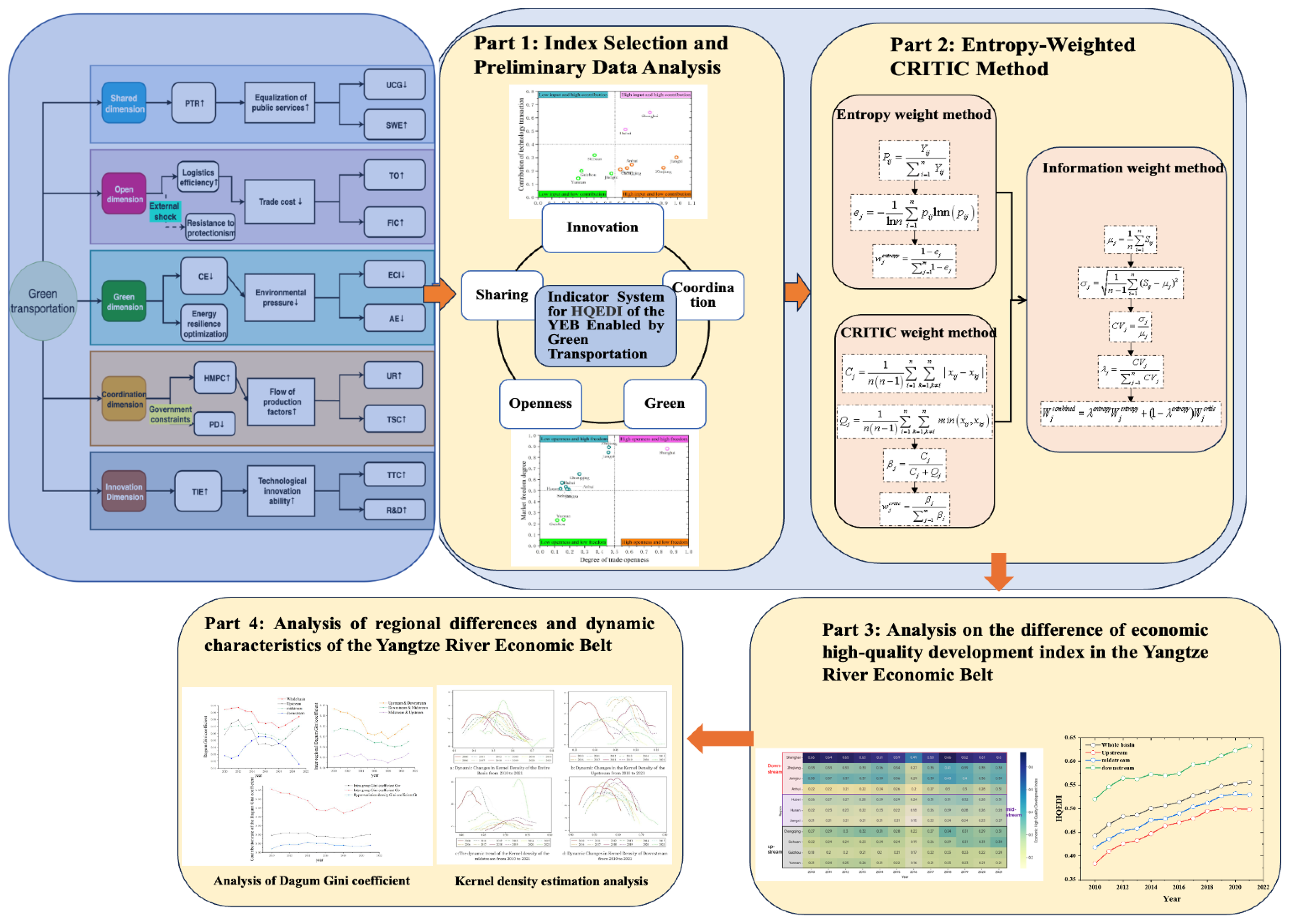
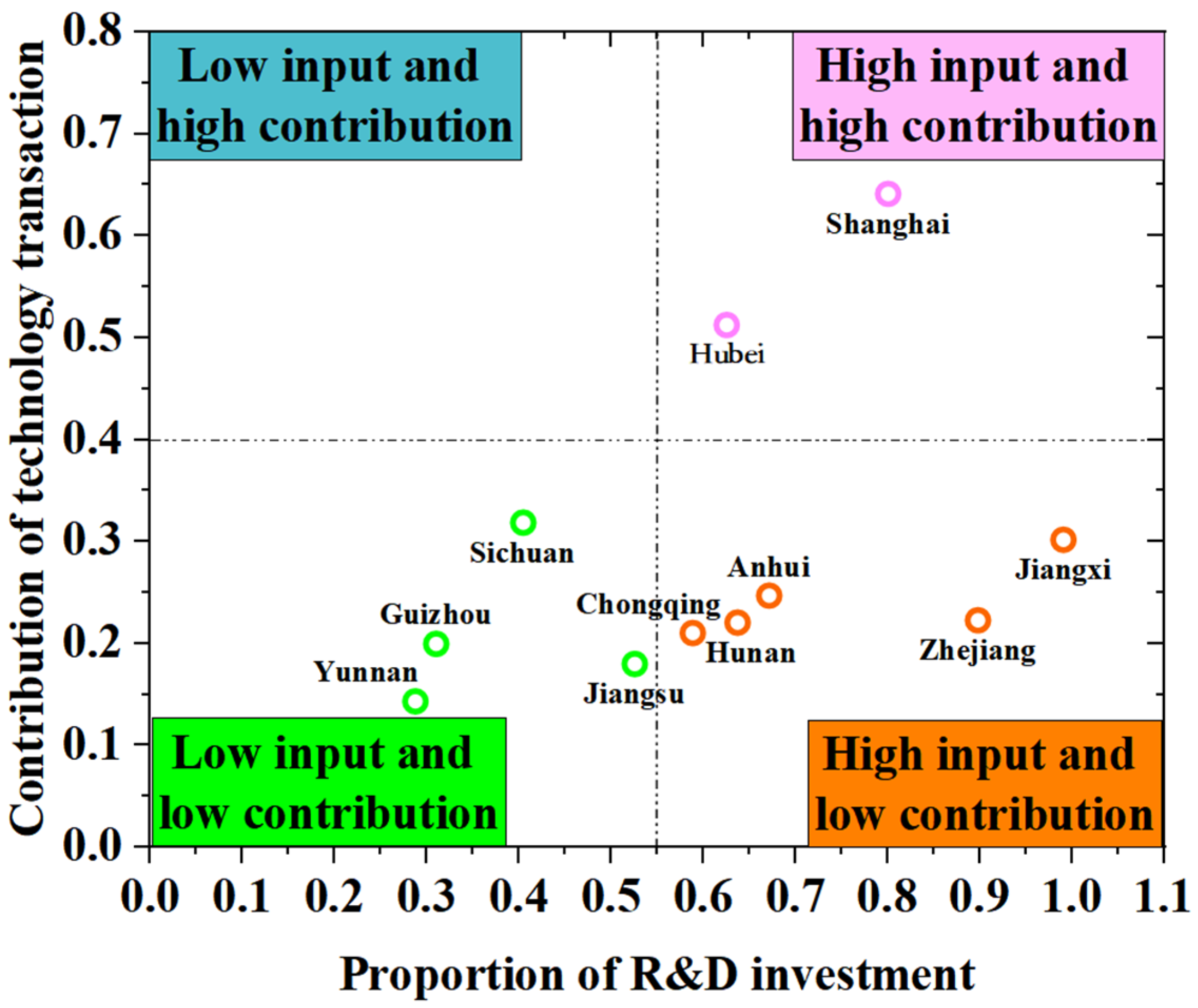


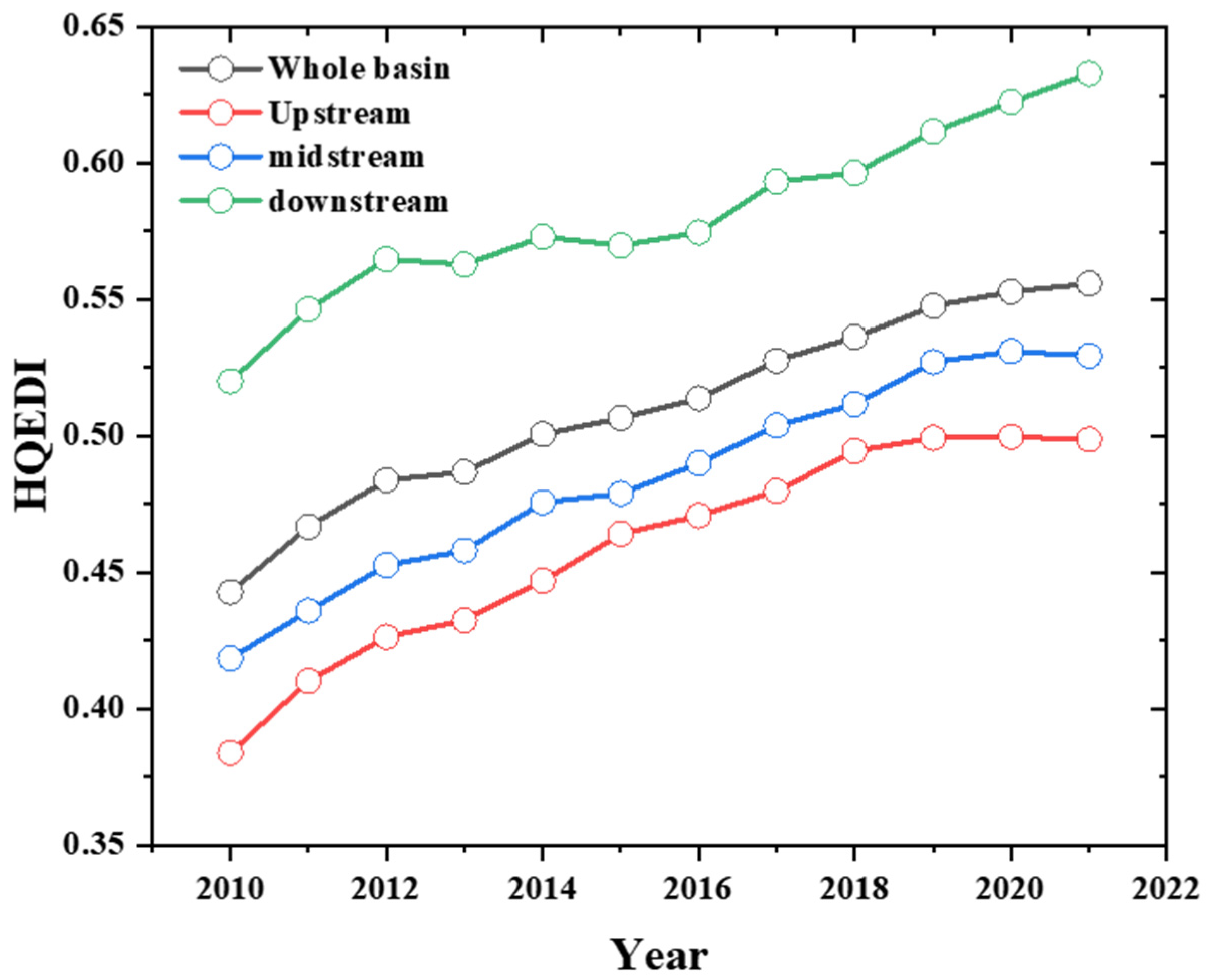
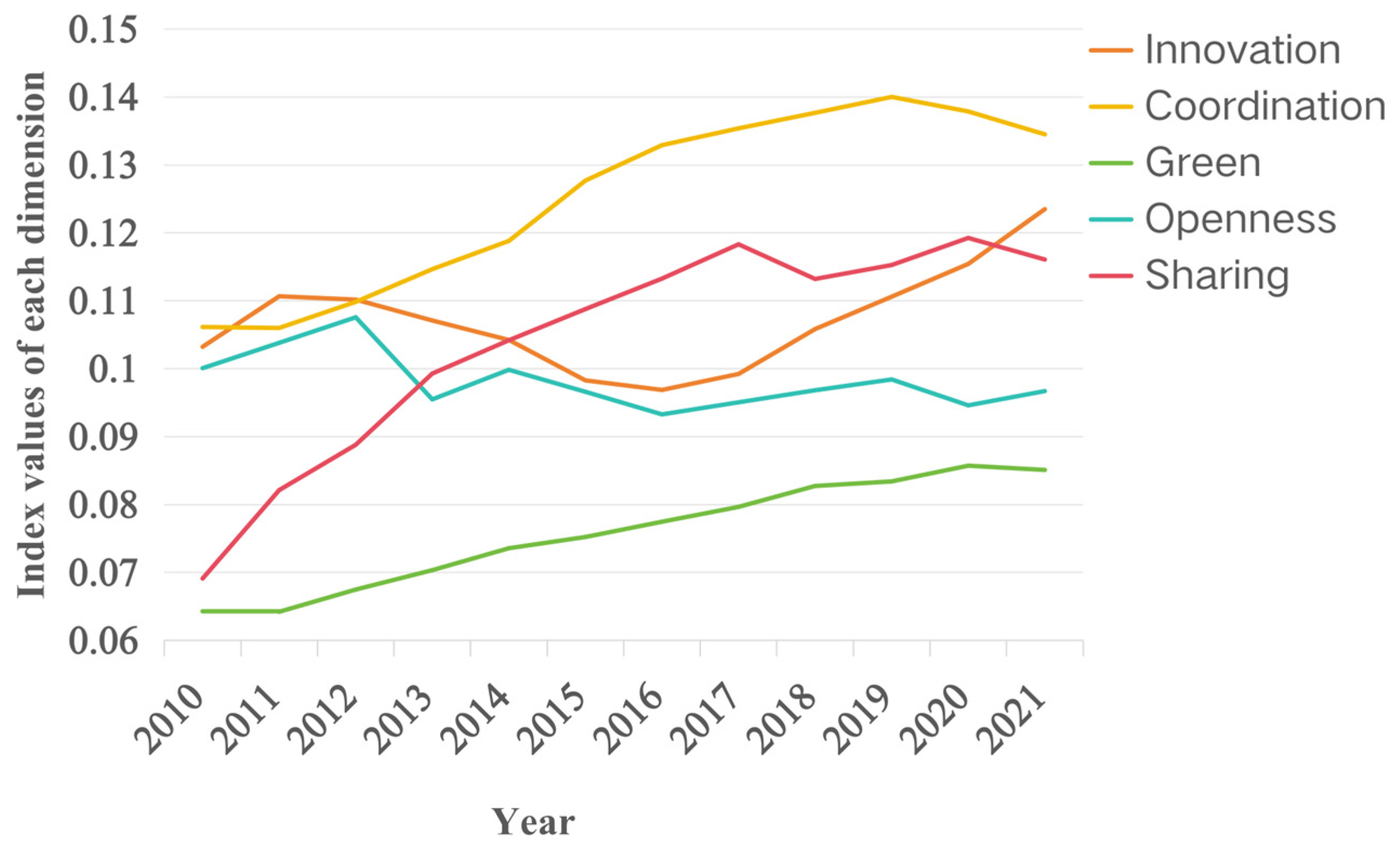
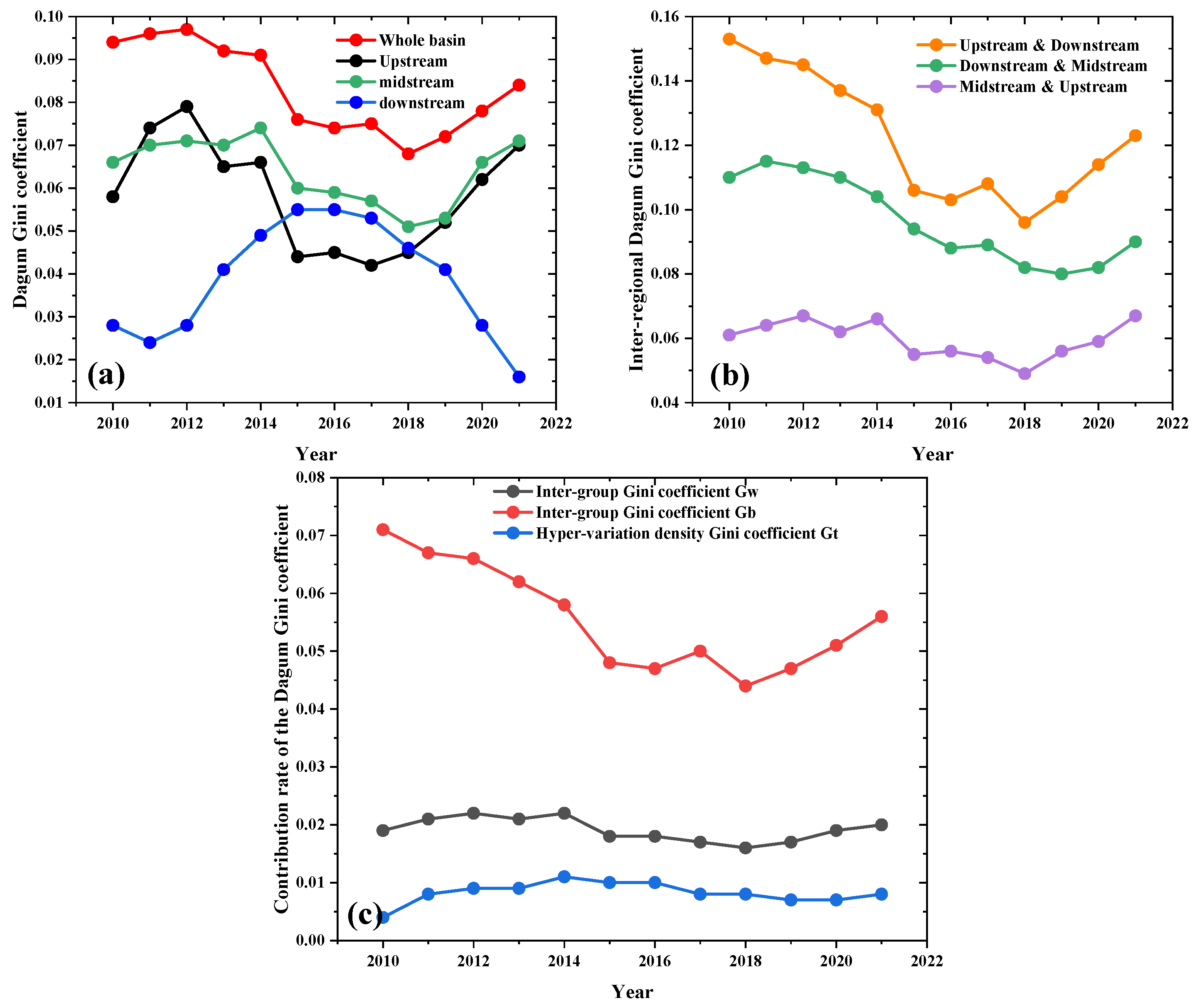

| Primary Indicator | Secondary Indicators | Indicator Definition | Abbreviation | Data Sources |
|---|---|---|---|---|
| Innovation | GDP growth rate (+) | Regional GDP growth rate | GDPGR | China Statistical Yearbook https://www.stats.gov.cn/sj/ndsj/ (accessed on 20 April 2025) |
| Proportion of R&D investment (+) | R&D expenditure of industrial enterprises above designated size/GDP | R&D | National Science and Technology Statistics Annual Report https://www.sts.org.cn/html/index.html (accessed on 20 April 2025) | |
| Return on investment (−) | Investment rate/regional GDP growth rate | ROI | Annual Statistical Report on Investment in Fixed Assets https://www.stats.gov.cn/sj/zxfb/202501/t20250117_1958329.html (accessed on 20 April 2025) | |
| Contribution of technology transactions (+) | Technology trading turnover/GDP | TTC | Annual Report on National Technology Market Statistics http://www.chinatorch.gov.cn/jssc/tjnb/list.shtml (accessed on 20 April 2025) | |
| Benefits of transportation Investment (+) | Added value of transport industry/fixed investment in transport industry (100 million yuan) | TIE | Yearbook of Transportation Statistics https://www.zgjtnjs.com/ (accessed on 20 April 2025) | |
| Coordination | Consumption structure (+) | Total retail sales of consumer goods/GDP | CS | China Statistical Yearbook https://www.stats.gov.cn/sj/ndsj/ (accessed on 20 April 2025) |
| Urbanization rate (+) | Urbanization rate | UR | China Statistical Yearbook https://www.stats.gov.cn/sj/ndsj/ (accessed on 20 April 2025) | |
| Public debt ratio (−) | Government debt balance/GDP | PD | China Financial Statistics Yearbook https://www.shujuku.org/tag/%E4%B8%AD%E5%9B%BD%E8%B4%A2%E6%94%BF%E5%B9%B4%E9%89%B4/ (accessed on 20 April 2025) | |
| Contribution of tertiary industry (+) | Increase in the ratio of the output value of the tertiary industry to regional GDP | TSC | China Statistical Yearbook https://www.stats.gov.cn/sj/ndsj/ (accessed on 20 April 2025) | |
| Highway mileage per capita (+) | Highway mileage/resident population | HMPC | Yearbook of Transportation Statistics https://www.zgjtnjs.com/ (accessedon 20 April 2025) | |
| Green | Energy consumption elasticity index (−) | Energy consumption growth rate/GDP growth rate | ECI | China Energy Statistical Yearbook https://www.stats.gov.cn/zsk/snapshoot?reference=2af5e433078f04afa4dd276ccda961e4_90491BA4193A4D4273403233ED6B1361&siteCode=tjzsk (accessed on 20 April 2025) |
| Wastewater volume per unit of output (−) | Wastewater discharge/GDP | WW | China Statistical Yearbook on Environment https://www.shujuku.org/tag/%E4%B8%AD%E5%9B%BD%E7%8E%AF%E5%A2%83%E7%BB%9F%E8%AE%A1%E5%B9%B4%E9%89%B4/ (accessed on 20 April 2025) | |
| Amount of exhaust gas produced per unit (−) | Sulfur dioxide emissions/GDP | AE | China Statistical Yearbook on Environment https://www.shujuku.org/tag/%E4%B8%AD%E5%9B%BD%E7%8E%AF%E5%A2%83%E7%BB%9F%E8%AE%A1%E5%B9%B4%E9%89%B4/ (accessed on 20 April 2025) | |
| Per capita transport carbon emissions (−) | Carbon dioxide emissions from transport sector/resident population | CE | China Statistical Yearbook on Environment https://www.shujuku.org/tag/%E4%B8%AD%E5%9B%BD%E7%8E%AF%E5%A2%83%E7%BB%9F%E8%AE%A1%E5%B9%B4%E9%89%B4/ (accessed on 20 April 2025) | |
| Openness | Trade openness (+) | Total imports and exports/GDP | TO | China Customs Statistical Yearbook http://www.customs.gov.cn/customs/302249/zfxxgk/2799825/302274/index.html (accessed on 20 April 2025) |
| Contribution rate of foreign investment (+) | Total foreign investment/GDP | FIC | China Statistical Yearbook on Foreign Economic Relations and Trade https://www.shujuku.org/tag/%E4%B8%AD%E5%9B%BD%E8%B4%B8%E6%98%93%E5%A4%96%E7%BB%8F%E7%BB%9F%E8%AE%A1%E5%B9%B4%E9%89%B4/ (accessedon 20 April 2025) | |
| Market freedom (+) | Regional marketization index | MF | Report on China’s Marketization Index https://baike.baidu.com/item/%E4%B8%AD%E5%9B%BD%E5%88%86%E7%9C%81%E4%BB%BD%E5%B8%82%E5%9C%BA%E5%8C%96%E6%8C%87%E6%95%B0%E6%8A%A5%E5%91%8A(2024)/65661354 (accessed on 20 April 2025) | |
| Travel activity (+) | Passenger traffic/resident population | MA | Yearbook of Transportation Statistics https://www.zgjtnjs.com/ (accessed on 20 April 2025) | |
| Sharing | Share of labor distribution (+) | Remuneration of workers/regional GDP | LS | China Labor Statistical Yearbook https://www.las.ac.cn/front/book/detail?id=8dbe7daeff2895635813c9ba21f9f630 (accessed on 20 April 2025) |
| RGC of residents’ income (+) | Per capita disposable income growth rate/regional GDP growth rate | IGE | China Statistical Yearbook https://www.stats.gov.cn/sj/ndsj/ (accessed on 20 April 2025) | |
| Urban–rural consumption difference rate (−) | Per capita consumption expenditure of urban residents/per capita consumption expenditure of rural residents | UCG | China Statistical Yearbook https://www.stats.gov.cn/sj/ndsj/ (accessed on 20 April 2025) | |
| Public welfare expenditure ratio (+) | Proportion of public welfare expenditure in local budget expenditure | SWE | China Financial Statistics Yearbook https://www.shujuku.org/tag/%E4%B8%AD%E5%9B%BD%E8%B4%A2%E6%94%BF%E5%B9%B4%E9%89%B4/ (accessed on 20 April 2025) | |
| Bus penetration rate (+) | Number of public transport vehicles per 10,000 people (mark platform) | PTR | Yearbook of Transportation Statistics https://www.zgjtnjs.com/ (accessed on 20 April 2025) |
Disclaimer/Publisher’s Note: The statements, opinions and data contained in all publications are solely those of the individual author(s) and contributor(s) and not of MDPI and/or the editor(s). MDPI and/or the editor(s) disclaim responsibility for any injury to people or property resulting from any ideas, methods, instructions or products referred to in the content. |
© 2025 by the authors. Licensee MDPI, Basel, Switzerland. This article is an open access article distributed under the terms and conditions of the Creative Commons Attribution (CC BY) license (https://creativecommons.org/licenses/by/4.0/).
Share and Cite
Li, C.; Deng, S.; Li, Y.; Zhu, L. Green Transportation-Enabled High-Quality Economic Development in the Yangtze River Economic Belt: Regional Disparities and Dynamic Characteristics. Sustainability 2025, 17, 6018. https://doi.org/10.3390/su17136018
Li C, Deng S, Li Y, Zhu L. Green Transportation-Enabled High-Quality Economic Development in the Yangtze River Economic Belt: Regional Disparities and Dynamic Characteristics. Sustainability. 2025; 17(13):6018. https://doi.org/10.3390/su17136018
Chicago/Turabian StyleLi, Cheng, Shiguo Deng, Yangzhou Li, and Liping Zhu. 2025. "Green Transportation-Enabled High-Quality Economic Development in the Yangtze River Economic Belt: Regional Disparities and Dynamic Characteristics" Sustainability 17, no. 13: 6018. https://doi.org/10.3390/su17136018
APA StyleLi, C., Deng, S., Li, Y., & Zhu, L. (2025). Green Transportation-Enabled High-Quality Economic Development in the Yangtze River Economic Belt: Regional Disparities and Dynamic Characteristics. Sustainability, 17(13), 6018. https://doi.org/10.3390/su17136018






